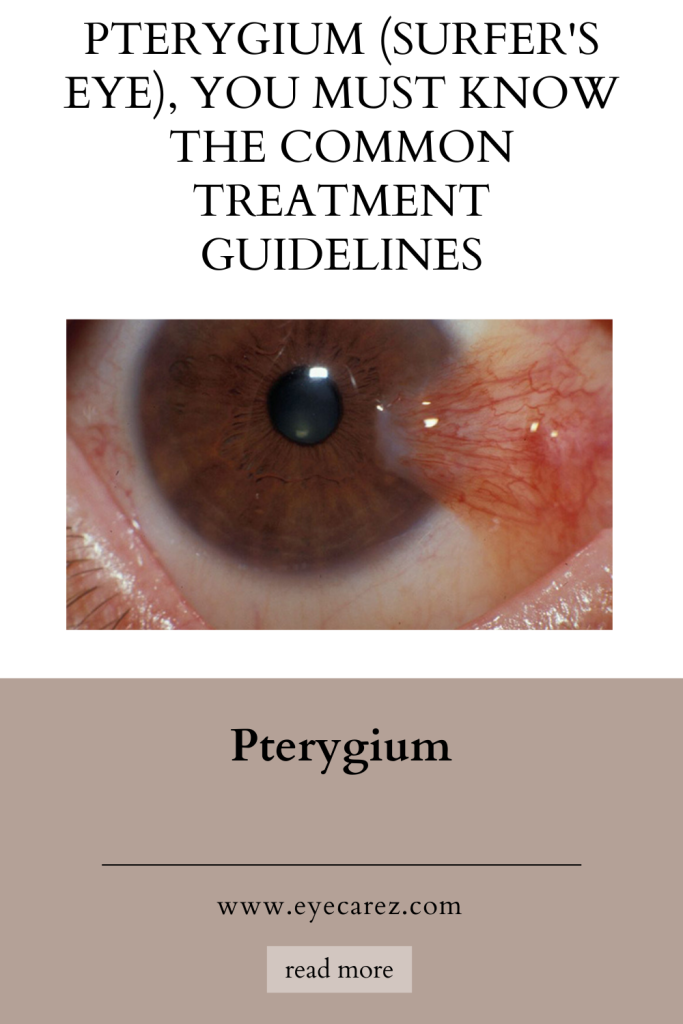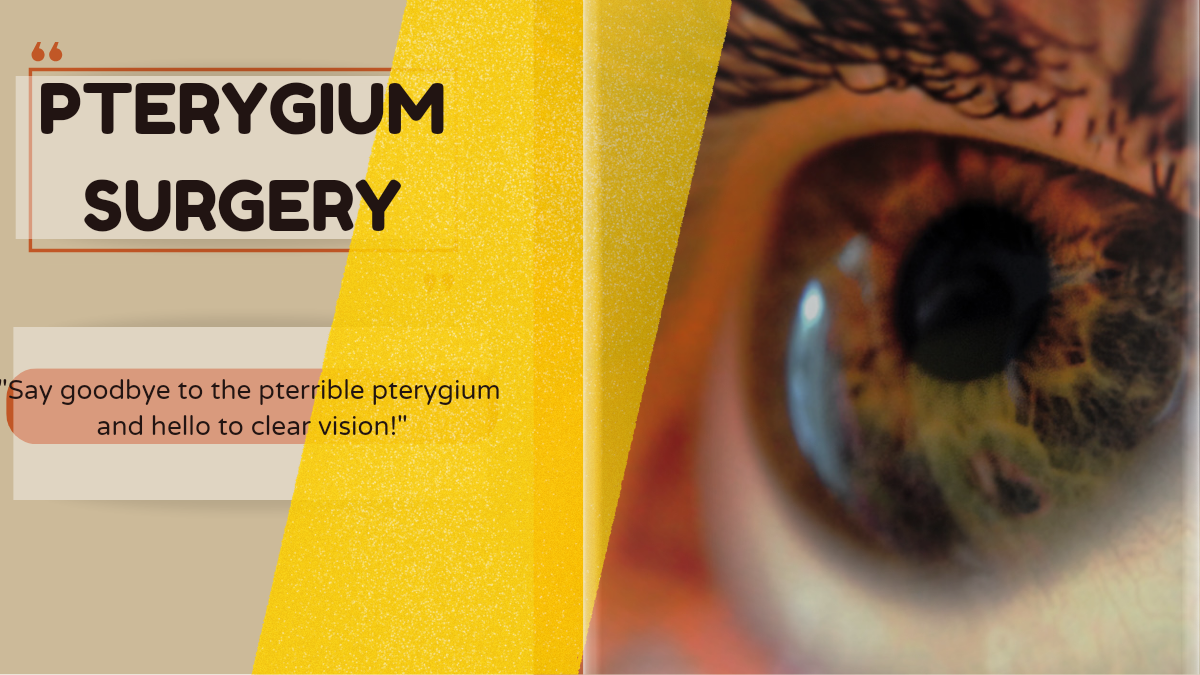Pterygium (Also known as Surfer’s Eye) is a common eye condition characterized by the growth of a fleshy, triangular-shaped tissue over the white part of the eye (sclera). It usually starts from the inner corner of the eye and gradually extends towards the cornea, which is the clear front surface of the eye.

Causes of Pterygium (Surfer’s Eye)
The exact cause of pterygium is unknown, but several factors are believed to contribute to its development, including:
- Prolonged exposure to ultraviolet (UV) light, especially from sunlight.
- Dry and dusty environments.
- Chronic irritation or inflammation of the eye.
- Genetic predisposition.
Symptoms of pterygium
Pterygium may not cause symptoms in its early stages, but as it grows, it can lead to various signs and symptoms, including:
- Redness and inflammation of the affected eye.
- Irritation, itching, or a gritty sensation.
- Blurred vision if the pterygium extends onto the cornea.
- Dryness and foreign body sensation.
- Distorted or altered shape of the affected eye.
Management and Treatment for Pterygium
Mild cases of pterygium may not require treatment if they do not cause significant symptoms or affect vision. However, if the pterygium causes discomfort, affects vision, or continues to grow, treatment options include:
- Lubricating eye drops or ointments to relieve dryness and discomfort.
- Steroid eye drops to reduce inflammation.
- Surgical removal of the pterygium if it causes severe symptoms or affects vision. The surgery aims to remove the abnormal tissue and may involve grafting healthy conjunctival tissue onto the affected area to reduce the chances of recurrence.
Complications of Pterygium
Pterygium can sometimes lead to complications, such as:
- Astigmatism: If the pterygium grows onto the cornea, it can change the shape of the cornea and cause astigmatism, leading to blurred or distorted vision.
- Visual Distortion: In advanced cases, pterygium can extend over the pupil and affect visual clarity.
- Recurrence: Pterygium can recur after surgical removal, especially if preventive measures like protective eyewear and avoiding UV exposure are not followed.
Prevention of Pterygium
Taking preventive measures can help reduce the risk of developing or worsening pterygium, including:
- Wearing sunglasses with UV protection to shield the eyes from harmful UV rays.
- Using lubricating eye drops in dry and dusty environments.
- Avoiding prolonged exposure to wind, dust, and other irritants.
- Using protective eyewear, such as goggles, when engaging in activities that may pose a risk of eye irritation or injury.
If you notice any abnormal growth or experience persistent eye discomfort or changes in vision, it is important to consult an eye care professional for an evaluation and appropriate management.
Frequently Asked Questions
We gathered the answers to some popular questions below.
If you can’t find your question below feel free to contact us, and we’ll be happy to help.
What are the main causes of pterygium?
Ultraviolet (UV) light exposure, Dry eye, Wind and dust exposure, Genetics, Age are the main causes of Pterygium.
What to avoid after pterygium surgery?
- Rubbing your eyes.
- Pressing on your eye.
- Getting soap or water in your eye.
- Swimming.
- Using eye makeup.
- Wearing contact lenses.
- Exercising strenuously.
- Being in dusty or windy environments.
Can pterygium causes blindness?
Yes, Bilateral Pterygium can cause reversible blindness.
How much does pterygium surgery cost?
The cost of pterygium surgery in the USA can vary depending on the state, the surgeon, and the type of surgery. In general, the cost ranges from $1,500 to $5,000 per eye.
Here is a breakdown of the cost of pterygium surgery in some states:
- California: $2,500 to $4,000 per eye
- Florida: $1,500 to $3,500 per eye
- New York: $2,000 to $4,500 per eye
- Texas: $1,800 to $3,800 per eye
- Washington: $2,200 to $4,200 per eye
How long after pterygium surgery can you drive?
You should wait at least 48 hours after pterygium surgery to drive. Communicate with your surgeon for further advises.
How do you treat pterygium without Surgery?
It depends on the condition of the pterygium. Mild asymptomatic cases scan be treated without surgery by prescribing eye drops.
What are the best or advance surgery for pterygium?
Excision of pterygium with conjunctival autograft
Excision with amniotic membrane transplantation
Excision with mitomycin C
Is it safe or is there any risk during surgery?
Infection, Bleeding, Regrowth, Dry eye, Pain and swelling, Scarring are some complications can occur.
Can pterygium be treated with eye drops only?
Yes, Sometimes pterygium can be treated with eye drops only in mild symptomatic patient.
What is the recovery time for pterygium surgery?
4-6 weeks . This can vary on every individuals.
What is the Success rate of pterygium surgery?
According to a 2019 study published in the journal Ophthalmology, the success rate of pterygium surgery ranges from 80% to 95%.
Will pterygium comeback after surgery?
Pterygium can recur after surgery, but the risk of recurrence varies depending on the type of surgery performed and the patient’s individual factors.
According to a 2019 study published in the journal Ophthalmology, the recurrence rate for pterygium surgery ranges from 5% to 30%. the recurrence rate for excision with amniotic membrane transplantation is about 5%, while the recurrence rate for excision alone is about 20%.
Can pterygium become cancerous?
Pterygium is a non-cancerous growth on the white part of the eye.
Is pterygium surgery painful?
Pterygium surgery is usually not painful. The eye is numbed with local anesthetic before the surgery, so you should not feel any pain during the procedure. However, you may experience some discomfort after the surgery, such as pain, redness, and swelling. This discomfort is usually mild and goes away on its own within a few days.
Which vitamin deficiency causes pterygium?
There is no evidence that vitamin deficiency causes pterygium.
However, some studies have shown that people with pterygium may have lower levels of certain vitamins, such as vitamin A, vitamin C, and vitamin E. These vitamins are important for eye health, and they may help to protect the eyes from UV damage.
When is pterygium surgery recommended?
- Persistent irritation that does not respond to medical therapy,
- When the fleshy growth causes blurry vision due to induced astigmatism.
- When the pterygium is increasing in size.
- When it restricts the movement of the eye.


